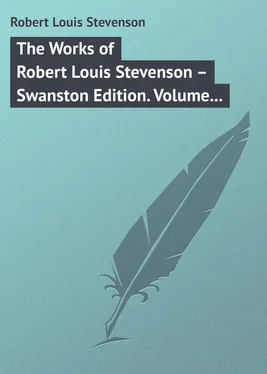Robert Stevenson - The Works of Robert Louis Stevenson – Swanston Edition. Volume 18
Здесь есть возможность читать онлайн «Robert Stevenson - The Works of Robert Louis Stevenson – Swanston Edition. Volume 18» — ознакомительный отрывок электронной книги совершенно бесплатно, а после прочтения отрывка купить полную версию. В некоторых случаях можно слушать аудио, скачать через торрент в формате fb2 и присутствует краткое содержание. Жанр: foreign_prose, на английском языке. Описание произведения, (предисловие) а так же отзывы посетителей доступны на портале библиотеки ЛибКат.
- Название:The Works of Robert Louis Stevenson – Swanston Edition. Volume 18
- Автор:
- Жанр:
- Год:неизвестен
- ISBN:нет данных
- Рейтинг книги:3 / 5. Голосов: 1
-
Избранное:Добавить в избранное
- Отзывы:
-
Ваша оценка:
- 60
- 1
- 2
- 3
- 4
- 5
The Works of Robert Louis Stevenson – Swanston Edition. Volume 18: краткое содержание, описание и аннотация
Предлагаем к чтению аннотацию, описание, краткое содержание или предисловие (зависит от того, что написал сам автор книги «The Works of Robert Louis Stevenson – Swanston Edition. Volume 18»). Если вы не нашли необходимую информацию о книге — напишите в комментариях, мы постараемся отыскать её.
The Works of Robert Louis Stevenson – Swanston Edition. Volume 18 — читать онлайн ознакомительный отрывок
Ниже представлен текст книги, разбитый по страницам. Система сохранения места последней прочитанной страницы, позволяет с удобством читать онлайн бесплатно книгу «The Works of Robert Louis Stevenson – Swanston Edition. Volume 18», без необходимости каждый раз заново искать на чём Вы остановились. Поставьте закладку, и сможете в любой момент перейти на страницу, на которой закончили чтение.
Интервал:
Закладка:
Stevenson Robert Louis
The Works of Robert Louis Stevenson – Swanston Edition, Vol. 18
EDITORIAL NOTE
The following chapters are selected from a series which was first published partially in ‘Black and White’ (February to December 1891), and fully in the New York ‘Sun’ during the same period. The voyages which supplied the occasion and the material for the work were three in number, viz. one of seven months (June 1888 to January 1889) in the yacht ‘Casco’ from San Francisco to the Marquesas, the Paumotus, Tahiti, and thence northward to Hawaii; a second (June to December 1889) in the trading schooner ‘Equator,’ from Honolulu, the Hawaiian capital, where the author had stayed in the intervening five months, to the Gilberts and thence to Samoa; and a third (April to September 1890) in the trading steamer ‘Janet Nicoll,’ which set out from Sydney and followed a very devious course, extending as far as Penrhyn in the Eastern to the Marshall Islands in the Western Pacific.
Before setting out on the first of these voyages, the author had contracted to write an account of his adventures in the form of letters for serial publication. The plan by and by changed in his mind into that of a book partly of travel and partly of research, which should combine the results of much careful observation and enquiry upon matters of island history, custom, belief, and tradition, with some account of his own experiences and those of his travelling companions. Under the nominal title of ‘Letters’ he began to compose the chapters of such a book on board the ‘Janet Nicoll,’ and continued the task during the first ten months of his residence in Samoa (October 1890 to July 1891). Before the serial publication had gone very far, he realised that the personal and impersonal elements in his work were not very successfully combined, nor in proportions that contented his readers. Accordingly he abandoned for the time being the idea of republishing the chapters in book form. But when the scheme of the Edinburgh Edition was maturing, he desired that a selection should be made from them and should form one volume of that edition. That desire was carried out. The same selection is here republished, with the addition of a half-section then omitted, describing a visit to the Kona coast of Hawaii and the lepers’ port of embarkation for Molokai.
It must be understood that a considerable portion of the author’s voyages above mentioned is not recorded at all in the following pages. Of one of its most attractive episodes, the visit to Tahiti, no account was written; while of his experiences in Hawaii only the visit to the Kona coast is included. Several chapters which did not come out to the writer’s satisfaction have been omitted. Of the five sections here given, each is complete in itself, with the exception of Part III. The first deals with the Marquesas, the second with the Paumolus – the former a volcanic and mountainous group, the latter a low group of atolls or coral islands, both in the Eastern Pacific and both under the protectorate of France. The third section is fragmentary, and deals, as has been said, with only one portion of the writer’s experiences in Hawaii. The last two describe his residence in the Gilberts, a remote and little-known coral group in the Western Pacific, which at the time of his visit was under independent native government, but has since been annexed by Great Britain. This is the part of his work with which the author himself was best satisfied, and it derives additional interest from describing a state of manners and government which has now passed away.
IN THE SOUTH SEAS
PART I
THE MARQUESAS IN THE SOUTH SEAS
CHAPTER I
AN ISLAND LANDFALL
For nearly ten years my health had been declining; and for some while before I set forth upon my voyage, I believed I was come to the afterpiece of life, and had only the nurse and undertaker to expect. It was suggested that I should try the South Seas; and I was not unwilling to visit like a ghost, and be carried like a bale, among scenes that had attracted me in youth and health. I chartered accordingly Dr. Merrit’s schooner yacht, the Casco , seventy-four tons register; sailed from San Francisco towards the end of June 1888, visited the eastern islands, and was left early the next year at Honolulu. Hence, lacking courage to return to my old life of the house and sick-room, I set forth to leeward in a trading schooner, the Equator , of a little over seventy tons, spent four months among the atolls (low coral islands) of the Gilbert group, and reached Samoa towards the close of ’89. By that time gratitude and habit were beginning to attach me to the islands; I had gained a competency of strength; I had made friends; I had learned new interests; the time of my voyages had passed like days in fairyland; and I decided to remain. I began to prepare these pages at sea, on a third cruise, in the trading steamer Janet Nicoll . If more days are granted me, they shall be passed where I have found life most pleasant and man most interesting; the axes of my black boys are already clearing the foundations of my future house; and I must learn to address readers from the uttermost parts of the sea.
That I should thus have reversed the verdict of Lord Tennyson’s hero is less eccentric than appears. Few men who come to the islands leave them; they grow grey where they alighted; the palm shades and the trade-wind fans them till they die, perhaps cherishing to the last the fancy of a visit home, which is rarely made, more rarely enjoyed, and yet more rarely repeated. No part of the world exerts the same attractive power upon the visitor, and the task before me is to communicate to fireside travellers some sense of its seduction, and to describe the life, at sea and ashore, of many hundred thousand persons, some of our own blood and language, all our contemporaries, and yet as remote in thought and habit as Rob Roy or Barbarossa, the Apostles or the Cæsars.
The first experience can never be repeated. The first love, the first sunrise, the first South Sea island, are memories apart and touched a virginity of sense. On the 28th of July 1888 the moon was an hour down by four in the morning. In the east a radiating centre of brightness told of the day; and beneath, on the skyline, the morning bank was already building, black as ink. We have all read of the swiftness of the day’s coming and departure in low latitudes; it is a point on which the scientific and sentimental tourist are at one, and has inspired some tasteful poetry. The period certainly varies with the season; but here is one case exactly noted. Although the dawn was thus preparing by four, the sun was not up till six; and it was half-past five before we could distinguish our expected islands from the clouds on the horizon. Eight degrees south, and the day two hours a-coming. The interval was passed on deck in the silence of expectation, the customary thrill of landfall heightened by the strangeness of the shores that we were then approaching. Slowly they took shape in the attenuating darkness. Ua-huna, piling up to a truncated summit, appeared the first upon the starboard bow; almost abeam arose our destination, Nuka-hiva, whelmed in cloud; and betwixt and to the southward, the first rays of the sun displayed the needles of Ua-pu. These pricked about the line of the horizon; like the pinnacles of some ornate and monstrous church, they stood there, in the sparkling brightness of the morning, the fit signboard of a world of wonders.
Читать дальшеИнтервал:
Закладка:
Похожие книги на «The Works of Robert Louis Stevenson – Swanston Edition. Volume 18»
Представляем Вашему вниманию похожие книги на «The Works of Robert Louis Stevenson – Swanston Edition. Volume 18» списком для выбора. Мы отобрали схожую по названию и смыслу литературу в надежде предоставить читателям больше вариантов отыскать новые, интересные, ещё непрочитанные произведения.
Обсуждение, отзывы о книге «The Works of Robert Louis Stevenson – Swanston Edition. Volume 18» и просто собственные мнения читателей. Оставьте ваши комментарии, напишите, что Вы думаете о произведении, его смысле или главных героях. Укажите что конкретно понравилось, а что нет, и почему Вы так считаете.










